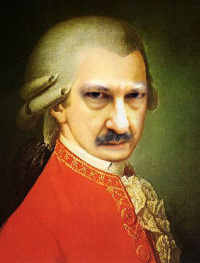A 365-Day Project
"We Are All Mozart"
A project to create
new works and change
the perception of the
music of our time.


 January 28, 2007
January 28, 2007 
It's slipping away. Seventeen straight hours of work, and the new piece is done, but the process of creating it is already fragmenting and dissolving in the air, like the remains of a dream as sun breaks.
There are enough fragments if I work quickly. First, the assignment: to create a composition for mezzo-soprano, violin, viola, and piano, a memorial piece, with a strong description. The commissioner, violinist Willie Docto, suggested people the instruments might represent and how they could interplay. He wrote:
|
The violin shall represent my mother, the viola shall represent my father, the mezzo shall represent their guardian angel. The piece could start with the two violins playing the same melody and harmony. This would represent the special love affair between the two. The mezzo can eventually join in the melody in the middle section. Towards the end of the piece the mezzo and the viola shall have the same melody and harmony, while the first violin plays another -- totally different -- melody. This would represent the parting of the two lovers and the guardian angel bringing my father to heaven. At the very end the three parts shall play the same melody/harmony and end together. This represents the reunion of both lovers with their guardian angel in eternity. |
He also suggested the text as being either the Lord's Prayer or Pie Jesu, both in Latin, or a vocalise à la Villa-Lobos.
Now that's a tough commission for a nonpop composer today -- not only the orchestration, not only the approach, but the detail that outlines a structure. And, in the spirit of this project, I took Willie at his word ... or as much as I could. The main problem for me lay in the text, which felt too clinical for such a personal piece. Yes, most folks don't find either text clinical, but the Latin gives me that feel in an instrumental situation. Call me a long-fallen Catholic. It happens.
So the text hunt began, and I turned to one of my favorite religious love texts: The Song of Songs. I selected seven lines that gave the sense of love, loss and expectation.
|
1:15. Behold, thou art fair, my love; behold, thou art fair; thou hast doves' eyes. |
Good enough. Oh -- and I used the Hebrew version of the text, in transliteration. And as the writing began, I kept in mind the idea of the line also being a vocalise.
Now the piece had actually been 'in the thinking' for a while because it was a large composition, a fully-formed expression of text and instrumental interplay. It had to work on several levels, including Willie's structural one. (Yes, it's all slipping away as I write these words.) There had to be nonstop energy in this piece, even as it was programmatic of love, death, departure and reunion. The form would progress, but also return not only to themes but to an architecture that joined beginning and end.
My floating modality popped up immediately, with its slippery harmonies and repetitive colorlessness that settles in like an evening fog. The highest intensity is at the moment the composition opens, with a nearly homophonic duet that slowly dismantles itself. The speed picks up in a kind of whirling dance between 'mother' and 'guardian angel' in a frenetic moment of departure, followed by the nervous stasis of the partner at a distance. The 'father' slips into a long, held A that disappears and transforms to an explosive rhythmic pizzicato.
The tableau is confused. The 'mother' is distant and in a different mode; the 'guardian angel' is chanting the words "many waters cannot quench love..." as comfort and warning. The pizzicati will not desist until finally the piano tumbles down as if the earth were pulling itself away. The opening strategy returns in simpler form, with a trio that resolves into simple octaves -- make haste, be quick. Finally, the colors diffuse as the listener to the music, still bound to the earth, cannot discern how the consonances and dissonances can all be joined.
That's as much as I can recall about the creative process of infusing the music with Willie's program. Most of it was a kind of subtext to the writing, and a simultaneous analysis was going on -- Does this invoke the ideas? Will it make musical sense? Is it working as a whole?
Here's the result. The score probably has typos and the layout isn't perfect ... I composed directly into the software this time, no pencil and paper. And there's also a demo, which could use better balance. Listen to it with this link. [Just noticed an error in the demo. The playback didn't pick up the pizzicato at measure 18. I'll fix it tomorrow or Tuesday.]
That's it. No photo today because I'm plain out of time. There's a family crisis and we have a three-hour drive beginning in five hours. Gotta sleep.